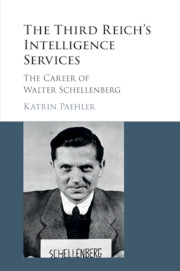Book contents
- Frontmatter
- Dedication
- Contents
- List of Figures
- Acknowledgments
- Archives
- Introduction
- 1 Gaining a Foothold
- 2 Rising Star
- 3 Intelligence Man
- 4 Office VI and Its Forerunner
- 5 Competing Visions: Office VI and the Abwehr
- 6 Doing Intelligence: Italy as an Example
- 7 Alternative Universes: Office VI and the Auswärtige Amt
- 8 Schellenberg, Himmler, and the Quest for “Peace”
- 9 Postwar
- 10 Concluding Thoughts
- Appendix
- Glossary
- Index
3 - Intelligence Man
Published online by Cambridge University Press: 31 March 2017
- Frontmatter
- Dedication
- Contents
- List of Figures
- Acknowledgments
- Archives
- Introduction
- 1 Gaining a Foothold
- 2 Rising Star
- 3 Intelligence Man
- 4 Office VI and Its Forerunner
- 5 Competing Visions: Office VI and the Abwehr
- 6 Doing Intelligence: Italy as an Example
- 7 Alternative Universes: Office VI and the Auswärtige Amt
- 8 Schellenberg, Himmler, and the Quest for “Peace”
- 9 Postwar
- 10 Concluding Thoughts
- Appendix
- Glossary
- Index
Summary
Major Schaemmel was the picture of a German military man, down to his impressive monocle. And the two British Secret Service agents with whom he met were delighted, because they had finally made contact with a member of the German military resistance. The initial meetings went well. Then, on November 9, 1939, a gun battle disrupted the quiet Dutch border town of Venlo. A Dutch officer died of the wounds sustained during the shoot-out, and the two Englishmen, Sigismund Payne Best and Richard Stevens, having fallen into a trap set by Gestapo and SD, were spirited off to Germany. Schaemmel, alias Schellenberg, arrived in Berlin to a hero's welcome. He had been in the thick of things; Hitler personally pinned the Iron Cross on his chest.
The kidnapping and gun battle at Venlo are the hinge between Schellenberg's past and future careers. Thus far, Schellenberg's career had rested on his administrative and legal expertise with the creation of the Reich Security Main Office as its capstone. It was to be seen whether Schellenberg would do equally well in the Gestapo's counterintelligence department, Department IV E. The incident at Venlo allowed Schellenberg to combine his cerebral image with a new reputation as a successful activist and bona fide intelligence man, and it served him well in his new position, for Schellenberg attempted to remake the department into a more ideologized entity with a broader mandate. He also became involved with some of the core developments related to the implementation and operations of Germany's nascent genocidal campaigns. Indeed, the years at the helm of IV E gave Schellenberg personal stature and presaged his later position as the head of the foreign intelligence. Poorly documented, these were formative years for an intelligence man and a differently conceptualized foreign intelligence service in the making.
Although the creation of the RSHA was imminent and no big administrative tasks were on the horizon, Schellenberg was not lacking prospects. Like for many men of his generation, the war brought excitement and opportunities. Schellenberg spent the first three weeks of World War II as a liaison between Heinrich Himmler and the Oberkommando der Wehrmacht (OKW), the High Command of the Armed Forces, traveling on Himmler's special train.
- Type
- Chapter
- Information
- The Third Reich's Intelligence ServicesThe Career of Walter Schellenberg, pp. 76 - 104Publisher: Cambridge University PressPrint publication year: 2017

